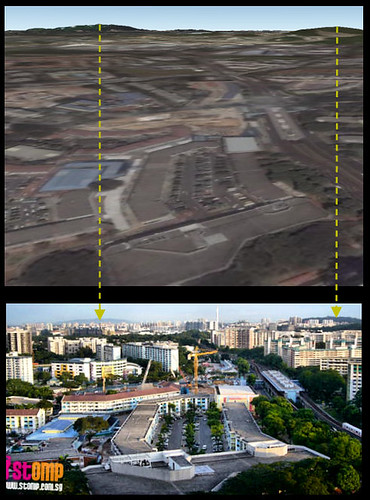Pages
Showing posts with label Map. Show all posts
Showing posts with label Map. Show all posts
Sep 18, 2012
Where the Canal and River Meet
Posted by
Icemoon
While I blog about geographical heritage, I do not usually pay much attention to the nature heritage around us. This has not changed much since 2009 when I failed to find the nutmeg trees in the Istana (what to do, without an identification guide, this city boy still can't). Few weeks ago however, this interesting sight of a transition between the man-made and the natural, where the canal meets the river, caught my attention.
Feb 28, 2012
How the Fort Canning Tunnel Altered our Road Landscape
Posted by
Icemoon
If we do a poll on the most detested and ugliest structure in town among heritage lovers, I suspect the honor would go to this tunnel through Fort Canning Hill. That time I checked out Orchard Presbyterian Church to investigate the 1984 curry murder, I saw its exit at Penang Road for the first time since it opened in 2007. I was momentarily at a loss for words staring at this edifice. Just as surprised would be the ancient kings of Temasek who could not have imagined a tunnel cutting right into their sacred Bukit Larangan.
Nov 29, 2010
How did Bishan Junction 8 get its name?
Posted by
Icemoon
Source: Streetdirectory.com
The other day I was reading my Facebook news feed when I learnt from yg on his wall that Sheng Shiong was having a closing down sale in 10th Mile Junction before its last day on 25 Nov. In case you do not know, the quite lifeless 10th Mile Junction would be developed into another concept mall leveraging on the railway history of the area and rebranded Junction 10. As if to remind us of the scarcity of land, 338 SOHO apartments would be built above the commercial podium.
Oct 27, 2010
Thank You for the Stamp Book - Singapore Stamps: Anniversaries & Milestones
Posted by
Icemoon
I decided to put off writing this until I could produce something more exciting than …. words.
Two Saturdays ago, I attended an oldies gathering at a food court. Now, if you read what yg and thimbuktu blogged about the session, it was supposed to be a soft launch for Dr Tan Wee Kiat’s new stamp book at SingPost Paya Lebar HQ. Confused? Well, turned out none of the attendees were below 50 (I was the youngest), the venue for the launch was the food court and the soft launch was actually a "soft launch" – a meeting to present autographed copies with "soft drinks" going around. That’s really funny, Dr Tan! Except that we did not order soft drinks – I had teh peng, a treat from yg and others drank mostly coffee or tea.
Jun 22, 2010
A Jungle before the Merlion Claimed One Fullerton?
Posted by
Icemoon
Source: Gary's Boring Blog
While the oldies are busy with the quiz on the north bank, I will blog about the Merlion on the other side of the Singapore River. I have blogged about this mythical creature aka 'mascot of Singapore' before, when it was struck by lightning. The topic today is nothing fishy and I promise it will be short.
Dec 6, 2009
From Soo Bee to See-May
Posted by
Icemoon
The last time I counted, four MRT stations had hanyu-pinyin mandarin names, out of the 70-odd stations in operation today. You may enumerate them - Yishun, Bishan, Hougang, Simei - and recall their old dialect identities - Nee Soon, Peck San, Ow Kang .... wait a minute, what's the last one again?
Sep 7, 2009
Vignettes in Time: Singapore Map and History Through the Centuries
Posted by
Icemoon

"This exhibition depicts Singapore as seen by cartographers, geologists, mariners, military generals and town planners. Beginning with the arrival of the British from the East India Company, to military strategists of Imperial Japan and postwar city planners, Vignettes in Time provides eclectic snippets of an emergent Singapore seen over the past two centuries."I visited the much anticipated exhibition on Saturday, September 5. There was an English Tour conducted from 3-4 but I only came to know of it at the NLB building lift lobby. The queue was empty so I went up on my own. I was halfway into the exhibition when the Tour arrived, announced by the crisp voice of the guide. Surprise surprise,
I was really lucky. According to NLB website, from September to October, a Tour is scheduled every Saturday - four English Tours, three Chinese tours and one Special Curator's Tour in English. I'm guessing Curator Chen will appear in the last one on October 10, but I caught him on September 5!
There is just too much to absorb from the exhibition. According to Chen, the librarian guides were put through a gruelling 5-6 hours of training to prepare them for the role. As visitors, we get to choose the galleries and exhibits to focus on. Here are the five galleries:
- Metropolis: The Growth of Modern Singapore 1965 - Present
- The Post War Aftermath 1945 - 1965
- The Rise and Fall of a Gilded Age 1900 - 1945
- 19th Century Origins 1819 - 1900
- Obscure Origins Pre - 1819
 Note that the galleries are arranged in reverse chronology. This was Chen's plan and I think he is smart. Lim Chen Sian is an archaeologist by training, but he did not follow the conventional chronological arrangement for galleries.
Note that the galleries are arranged in reverse chronology. This was Chen's plan and I think he is smart. Lim Chen Sian is an archaeologist by training, but he did not follow the conventional chronological arrangement for galleries.The two star attractions are the Secret Papers of General Utsunomiya on Operation Nanpo and The Earliest Images of Singapore.
If you like Singapore map and history, do head down to the National Library. The exhibition will end 31 October 2009.
Jan 13, 2009
A Street Directory on your Handphone
Posted by
Icemoon
When I bought the latest Street Directory many many weeks ago, it came with an unexpected surprise.

No lah, they didn't give away free mobile. That would be the sun rising from the west.
The Street Directory was more than a book. The whole package consisted of the street directory ($12.90), a consumer guide ($7.00) and a CD ($30.00). I think I paid only $12.90, so the guide and CD were supposedly free.
The gem was the CD itself. There was a digital street directory software for the PC - nay, nothing to rave about, just an electronic version of the paper book. There was also another version for Pocket PC, PDA and SmartPhone. Oh!
If you're like me without the luxury of a mount, a street directory for your mobile will come in useful and I mean indispensable. Out there, you wouldn't want to bring a big street directory along. You rather save the space in your bag for food, water and insect repellant. Of course you don't want to get lost.
 Image from Know Your Mobile - Plan a route using Maps on the Nokia N95. I don't own the newer Nokias with GPS maps, can't comment on their usefulness. For you lucky owners out there, maybe you can enlighten me on the state of the art.
Image from Know Your Mobile - Plan a route using Maps on the Nokia N95. I don't own the newer Nokias with GPS maps, can't comment on their usefulness. For you lucky owners out there, maybe you can enlighten me on the state of the art.
The mobile street directory is truly a no-frills version, no more than a collection of map images with basic search function. Such software may be passe with the advent of GPS-driven navigation software, but its simplicity may be a boon rather than a bane in everyday usage.
Let's have a quick look at the search function. You can search by Places of Interest, Road and by using the free-form search.
 Example of searching by Places of Interest. Select POI -> Bus Interchange -> Ang Mo Kio.
Example of searching by Places of Interest. Select POI -> Bus Interchange -> Ang Mo Kio.
 Example of searching by Road. Select Road -> A -> Abbotsingh Road.
Example of searching by Road. Select Road -> A -> Abbotsingh Road.
 Example of free-form search. Select Search -> (type any text). Ignore the Chinese 'pinyin' input. There is no Chinese search functionality. I have been sms-ing my Mainlander subordinate too much.
Example of free-form search. Select Search -> (type any text). Ignore the Chinese 'pinyin' input. There is no Chinese search functionality. I have been sms-ing my Mainlander subordinate too much.
There is also a bookmark function which is quite neat. You can do research before the trip and save the result as a bookmark.
 Bookmark function. You can go to a saved bookmark, add current location as a bookmark or simply remove the current bookmark.
Bookmark function. You can go to a saved bookmark, add current location as a bookmark or simply remove the current bookmark.
The maps are actually images of the paper version. You can do directional scrolling on this 'map of Singapore', unlike on a book where you have to manually flip the pages.
Unlike Google Map, this is not a true map software. You cannot zoom, for starters. Neither can you drop placemarks. The software has no online component, so you cannot share your work with others. Of course there is no GPS functionality. If you are the kind who is hopelessly lost on the street, this is not for you.
To me, the software is a replacement for the paper street directory. It is good enough for my usual heritage exploration. At least I know the bus stop location, street layout and surrounding landmarks. If I'm on a wild trail, I prefer using mysuperbly lousy navigation and bashing skills.
Finding direction the old fashioned way is also nostalgic. Before we have in-car GPS navigators, the human navigator sits beside the driver with a map on the lap. If it comes to the "uh-oh-I-think-we-are-lost" situation, the back passengers are activated to look for landmarks as well.
This is a rather compelling reason for me to continue using the mobile street directory. You cannot afford to be complacent since you are an active participant in the navigation. The participatory role makes you more aware of your surrounding - the buildings, the roads, the streets, the river - our heritage.

No lah, they didn't give away free mobile. That would be the sun rising from the west.
The Street Directory was more than a book. The whole package consisted of the street directory ($12.90), a consumer guide ($7.00) and a CD ($30.00). I think I paid only $12.90, so the guide and CD were supposedly free.
The gem was the CD itself. There was a digital street directory software for the PC - nay, nothing to rave about, just an electronic version of the paper book. There was also another version for Pocket PC, PDA and SmartPhone. Oh!
If you're like me without the luxury of a mount, a street directory for your mobile will come in useful and I mean indispensable. Out there, you wouldn't want to bring a big street directory along. You rather save the space in your bag for food, water and insect repellant. Of course you don't want to get lost.
 Image from Know Your Mobile - Plan a route using Maps on the Nokia N95. I don't own the newer Nokias with GPS maps, can't comment on their usefulness. For you lucky owners out there, maybe you can enlighten me on the state of the art.
Image from Know Your Mobile - Plan a route using Maps on the Nokia N95. I don't own the newer Nokias with GPS maps, can't comment on their usefulness. For you lucky owners out there, maybe you can enlighten me on the state of the art.The mobile street directory is truly a no-frills version, no more than a collection of map images with basic search function. Such software may be passe with the advent of GPS-driven navigation software, but its simplicity may be a boon rather than a bane in everyday usage.
Let's have a quick look at the search function. You can search by Places of Interest, Road and by using the free-form search.
 Example of searching by Places of Interest. Select POI -> Bus Interchange -> Ang Mo Kio.
Example of searching by Places of Interest. Select POI -> Bus Interchange -> Ang Mo Kio. Example of searching by Road. Select Road -> A -> Abbotsingh Road.
Example of searching by Road. Select Road -> A -> Abbotsingh Road. Example of free-form search. Select Search -> (type any text). Ignore the Chinese 'pinyin' input. There is no Chinese search functionality. I have been sms-ing my Mainlander subordinate too much.
Example of free-form search. Select Search -> (type any text). Ignore the Chinese 'pinyin' input. There is no Chinese search functionality. I have been sms-ing my Mainlander subordinate too much.There is also a bookmark function which is quite neat. You can do research before the trip and save the result as a bookmark.
 Bookmark function. You can go to a saved bookmark, add current location as a bookmark or simply remove the current bookmark.
Bookmark function. You can go to a saved bookmark, add current location as a bookmark or simply remove the current bookmark.The maps are actually images of the paper version. You can do directional scrolling on this 'map of Singapore', unlike on a book where you have to manually flip the pages.
Unlike Google Map, this is not a true map software. You cannot zoom, for starters. Neither can you drop placemarks. The software has no online component, so you cannot share your work with others. Of course there is no GPS functionality. If you are the kind who is hopelessly lost on the street, this is not for you.
To me, the software is a replacement for the paper street directory. It is good enough for my usual heritage exploration. At least I know the bus stop location, street layout and surrounding landmarks. If I'm on a wild trail, I prefer using my
Finding direction the old fashioned way is also nostalgic. Before we have in-car GPS navigators, the human navigator sits beside the driver with a map on the lap. If it comes to the "uh-oh-I-think-we-are-lost" situation, the back passengers are activated to look for landmarks as well.
This is a rather compelling reason for me to continue using the mobile street directory. You cannot afford to be complacent since you are an active participant in the navigation. The participatory role makes you more aware of your surrounding - the buildings, the roads, the streets, the river - our heritage.
Nov 14, 2008
Recognise what mountain this is?
Posted by
Icemoon
Came across this on STOMP:

Singapore's No. 1 citizen journalism website with 12 million monthly page views issued this challenge arousing my interest. This heritage hobbyist with growing interest in the natural geography just couldn't resist taking up the challenge.
My initial impression of the first photo was of incredulity. With a mountain range towering behind the tall buildings, you thought when did Singapore have her own Mount Kilimanjaro? I have not had the luxury to admire the scenery from a tall building in Clementi, but I know Bukit Timah/Gombak/Batok lie nearby. This mountain, however, lies much further away. Does such a mountain exist? What can be more shocking than if you wake up one day and suddenly find a mountain on the horizon? Either you are dreaming or Uncle Yu moved the mountain (寓公移山).
But you will not find such a view in Clementi. The first photo is zoomed, so the mountain looks smaller in reality. From Albert's home in Clementi Avenue 3, you should see something like in the second photo. In the second photo, we see two mountains. The one on the left - our Kilimanjaro - is still shrouded in mystery. The one on the right looks easy with her proximity to Clementi. We'll find out in a moment.
The right one is easy, I suppose most STOMP comments got the right one right or near. By right, the challenge is with the left one, not right. So by answering the right one, how can they be right? I guess some people gave up left right and came up with Fuji, Kinabalu, Ice Mountain and yes, there's even Brokeback. They are joking, am I right?

Do you want to find out its real name? I sure do, so we need to enlist the help of our friend again. Previously she helped me confirm the mysterious mountain of the 1960s which turned out to be Bukit Gombak.
Get ready to be excited. Firing up the client, you can't wait for the globe to rotate to Singapore. You know where you should stop from the position of Clementi MRT Station in the photo. You pan to the location, descend to the approximate elevation and look straight at the horizon, expecting to see the mountain on the left. If you don't, then perhaps the mountain was built out of a mole-hill before Google could update the map.
I did find my Kilimanjaro on the horizon after some adjustment. I almost missed it as the mountain disappears at low elevation.
Google Earth view of the photo. The two mountains can be seen clearly.
I was off to the mountain - flying like Superman to the destination - the moment "Kilimanjaro" appeared in sight. Even Superman takes time to fly, so in the meantime let's take a look at the mountain on the right which we have neglected. Look carefully, there are actually two of them, two hills to be exact.
View Larger Map
Line of sight to the two hills. It is easy to find Albert's place from the MRT station in the photo. This will be our origin point. From there, extrapolate the line of sight to the hills in the general direction.
Line of sight to Bukit Gombak and the mountain.
STOMPer Albert took these photos from his home in Clementi Avenue 3, which show a mountain in the background.
He says:
"These photos were taken from my house at Clementi Ave 3, facing Clementi MRT station.
"The mountain can be seen on clear days or just after a heavy shower."
Do you recognise what mountain this is?

Singapore's No. 1 citizen journalism website with 12 million monthly page views issued this challenge arousing my interest. This heritage hobbyist with growing interest in the natural geography just couldn't resist taking up the challenge.
My initial impression of the first photo was of incredulity. With a mountain range towering behind the tall buildings, you thought when did Singapore have her own Mount Kilimanjaro? I have not had the luxury to admire the scenery from a tall building in Clementi, but I know Bukit Timah/Gombak/Batok lie nearby. This mountain, however, lies much further away. Does such a mountain exist? What can be more shocking than if you wake up one day and suddenly find a mountain on the horizon? Either you are dreaming or Uncle Yu moved the mountain (寓公移山).
But you will not find such a view in Clementi. The first photo is zoomed, so the mountain looks smaller in reality. From Albert's home in Clementi Avenue 3, you should see something like in the second photo. In the second photo, we see two mountains. The one on the left - our Kilimanjaro - is still shrouded in mystery. The one on the right looks easy with her proximity to Clementi. We'll find out in a moment.
The right one is easy, I suppose most STOMP comments got the right one right or near. By right, the challenge is with the left one, not right. So by answering the right one, how can they be right? I guess some people gave up left right and came up with Fuji, Kinabalu, Ice Mountain and yes, there's even Brokeback. They are joking, am I right?

A Brokeback Mountain in Singapore? Not anytime soon.
Do you want to find out its real name? I sure do, so we need to enlist the help of our friend again. Previously she helped me confirm the mysterious mountain of the 1960s which turned out to be Bukit Gombak.
Get ready to be excited. Firing up the client, you can't wait for the globe to rotate to Singapore. You know where you should stop from the position of Clementi MRT Station in the photo. You pan to the location, descend to the approximate elevation and look straight at the horizon, expecting to see the mountain on the left. If you don't, then perhaps the mountain was built out of a mole-hill before Google could update the map.
I did find my Kilimanjaro on the horizon after some adjustment. I almost missed it as the mountain disappears at low elevation.
Google Earth view of the photo. The two mountains can be seen clearly.
I was off to the mountain - flying like Superman to the destination - the moment "Kilimanjaro" appeared in sight. Even Superman takes time to fly, so in the meantime let's take a look at the mountain on the right which we have neglected. Look carefully, there are actually two of them, two hills to be exact.
Line of sight to the two hills. It is easy to find Albert's place from the MRT station in the photo. This will be our origin point. From there, extrapolate the line of sight to the hills in the general direction.
Sorry to disappoint the Bukit Timah supporters. You are mistaken if you think the Tin Hill is one of them.
Ok, Superman should have reached his destination now. Ooh, and with the realization he is in Malaysian airspace. Superman boleh! Needless to say, our superhero does not need a passport.
Top: The mountain at close range, from Google Earth.
Bottom: The mountain in the background of the photo.
So where is this mountain? I give you a clue - it is pretty near a resort with golf course. In fact I was at this resort quite recently.
View Larger Map
Bottom: The mountain in the background of the photo.
So where is this mountain? I give you a clue - it is pretty near a resort with golf course. In fact I was at this resort quite recently.
Sep 11, 2008
Where is the Location of that Artillery Gun? A Second Shot Mission
Posted by
Icemoon
Thanks to Chun See's kind recommendation, I'm now on this mystery as well.
For those who have not read Chun See's blog articles on the mystery, you can go here and here. There is also the forum where a discussion is held among old British soldiers ('lau pengs') on the same topic which you can read it here.
To summarise, there are actually two mysteries - the location of H Sub Section and the location in Roger-Hatchy's photo. Or is it? Can they be the same mystery after all, with Roger-Hatchy's photo showing the location of H-Sub?
Like Chun See, the mysteries are also driving me (chest)nuts. I have been thinking of them over the weekend, poured over maps and executed a "second shot" mission to recce possible sites.
The process is nothing short of exciting. Here I thank Chun See for giving me the idea for the mission and I definitely agree with Peter when he said, "Wah this is so exciting trying to find old places."
Two things can be confirmed about the mysteries. Both locations were in the Tengah area and both gun deployments happened in the 1960s. If you were not around in the 1960s like me, you may be disadvantaged when trying to solve such mysteries. So without further ado, let me bring you back in time, to the Tengah area of the 1960s ....
Before we look at the 1960s version, let's see how the area looks like today. A quick (and small) one.
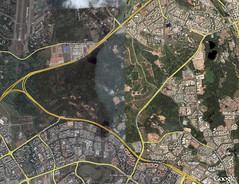
Courtesy of Google Earth. Highlighted lines are major roads. Start at Tengah Flyover where PIE joins KJE (near the left edge). If you are a driver or a resident in the area, the rest should be easy. Clockwise from Tengah Flyover, Tengah Airbase, the residental estates of Choa Chu Kang, Teck Whye, Bukit Batok, Jurong East and Jurong West (separated from its East sibling by a vertical canal).
In the 1960s, the residential estates had not existed. Neither were there PIE nor KJE. Instead life was concentrated in the kampongs located along the milestones of Choa Chu Kang Road and Jurong Road.
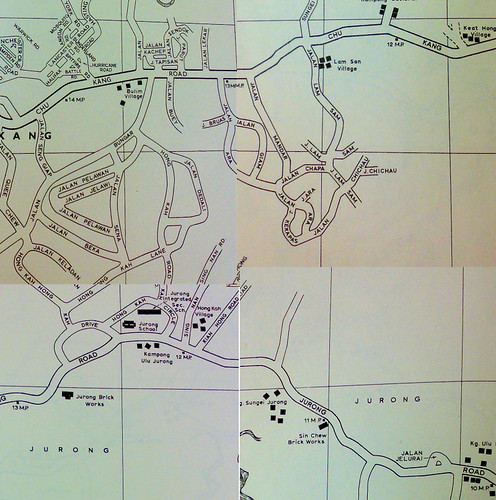
From Street Directory, circa 1966. Choa Chu Kang Road at the top, Jurong Road at the bottom. Note the kampongs alongside.
So we have the old and new map of the area. In 40 years much have changed. For example, Hong Kah Village is gone and the name today is mostly synonymous with the electoral boundary. Thus with respect to the boundary set by the government, the maps do not actually show Tengah but Hong Kah. But because the old British soldiers take Tengah as a reference (the runway of Tengah Airbase was a prominent landmark from high ground), and that happens to be the locality name they remember most vividly, I will call the area Tengah.
As part of my second shot hobby, I like to find traces of old roads and imagine how they looked like before they got realigned or expunged. Unlike the oldies, I have no recollection of the old roads so I can only imagine. Luckily digital tools can help us bridge the gap.
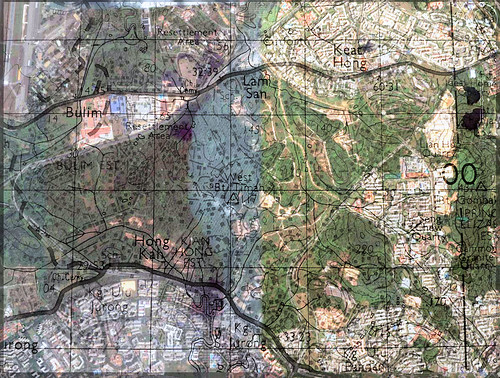
Overlay of a 1966 topographical map on Google Earth.
Looking at the overlay, I can finally trace out Choa Chu Kang Road or what was once it. From Tengah Airbase, the current Old Choa Chu Kang Road is the old one. At Track 14, it cuts across the KJE diagonally, parallels Jalan Lam Sam and the canal bridge, cuts the flats around Blk 462 and the field beside Avenue 5. Then at Old Keat Hong Camp I, I think it goes into the camp compound. In any case, it links up with Avenue 1 after the MRT underpass outside Camp II, cuts the field opposite Keat Hong LRT Station and finally links up with Choa Chu Kang Road at Teck Whye LRT Station.
Do you know where is this place? Note that the photo is over 40 years old.
 The photo posted by Roger Hatchy in the forum. This and more photos in his Photobucket.
The photo posted by Roger Hatchy in the forum. This and more photos in his Photobucket.
Having lived in the Chestnut Drive area for 25 years as a child, Peter was quick to point out the 'mountain range' as Bukit Gombak. In particular, he recognized RAF Gombak radar station on the ridge. According to him, this is the view of Bukit Gombak from the Choa Chu Kang side.
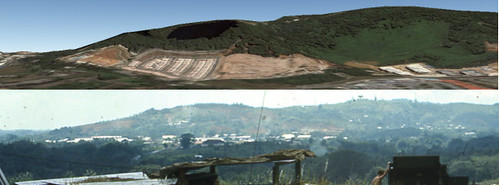
Top: Google Earth Terrain showing Bukit Gombak.
Bottom: The mysterious mountain of the 1960s from the Roger Hatchy photo.
Dear readers, what do you think?
To verify my hypothesis and to get a feel of the land, I executed a second shot mission. The plan was to walk along Track 22/Jalan Chichau/Jalan Lam San and survey the terrain, noting any possible targets. This seems to be the only road that cuts through the jungle mass between PIE and KJE. Then I would cross KJE to reach Jalan Lekar and check out Chun See's hypothesis as well.
Not sure why, but I sensed some of the passengers looking at me weirdly when I alighted from 174 at the Track 22 bus-stop.
In the Roger Hatchy photo, the camera seems to be facing Bukit Gombak perpendicularly and the saddle is at the center of the picture. Looking at the topographical map, there are two likely locations. The first is West Bukit Timah 117 and the second is Hill 140. I think I might have climbed up 117 located on the left side of the road. However the trees have grown quite tall and I couldn't even see Bukit Gombak, though I caught a glimpse of a tower (on Bukit Gombak) through the canopy. 140 is located at the end of the road that crosses the canal. It is unmistakable, the road cuts through a big field and there is even a road up the hill. Unfortunately, wild dogs guard the end of the road. I was scared so I turned back.

Topographical map of 1966 showing West Bukit Timah 117 and 140. Standing on these hills, you will face Bukit Gombak perpendicularly and the saddle will be to your center.

Bukit Gombak from Hill 140. Looking at the topographical map, there should be a Hill 115 in front. I think it was flattened to develop Bukit Batok West.
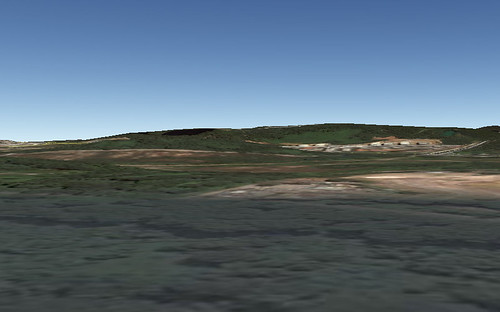
Bukit Gombak from Hill 117. Hill 140 is in front.
The only clue on the location of H Sub comes from the description of Ken Nichols in two places:
To summarise using Chun See's words:
Thus Chun See's hypothesis:
Peter, however, did not share the same view. In the forum, he wrote:
Therefore in Peter's view, they were travelling along Jurong Road rather than Choa Chu Kang road. I think this is a crucial difference that can break either hypothesis. So what was the favoured road to Tengah from the city of Singapore in the 1960s? Or did Ken take the less favoured road?
I went to the area mentioned in Chun See's hypothesis to check out the terrain. As it was near evening and I'm not cavalry, I did not manage to recce the whole Jalan Lekar/Jalan Semangka area but just Track 14. I knew about the cemetery from a friend living in Choa Chu Kang so I thought of going there to have a look.
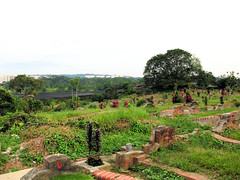
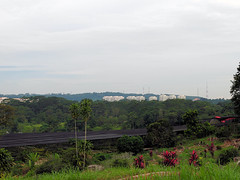
Left: Cemetery at Track 14. Background shows Bukit Gombak.
Right: Close up view of Bukit Gombak from the same position.
The cemetery is on a small hill and I went to the top to take that shot. Bukit Gombak looks so small in the background, so Jalan Lekar/Jalan Semangka cannot be the location of Roger Hatchy's photo.
I believe I might have found the site of Roger Hatchy's photo. Of the two likely locations, I pick Hill 140. The hills around 117 are a bit far away from Bukit Gombak.; if you look at the topographical map, Track 14 lies roughly along the same vertical axis as 117, but in my cemetery photo, Bukit Gombak looks so small. I'm not sure if you were to stand on 117 with a clear view of Bukit Gombak, the latter will look much much bigger. Furthermore from 117, 220 lies in front, but in the Roger Hatchy photo, the hill in front does not look any higher than the gun hill. If it was 140, 220 would not be in the photo, instead 115 would be in front, which is around the same height as the gun hill. Unfortunately, I think 115 was flattened to make way for Bukit Batok West so there is no way to verify using Google Earth.
Comments?
For those who have not read Chun See's blog articles on the mystery, you can go here and here. There is also the forum where a discussion is held among old British soldiers ('lau pengs') on the same topic which you can read it here.
To summarise, there are actually two mysteries - the location of H Sub Section and the location in Roger-Hatchy's photo. Or is it? Can they be the same mystery after all, with Roger-Hatchy's photo showing the location of H-Sub?
Like Chun See, the mysteries are also driving me (chest)nuts. I have been thinking of them over the weekend, poured over maps and executed a "second shot" mission to recce possible sites.
The process is nothing short of exciting. Here I thank Chun See for giving me the idea for the mission and I definitely agree with Peter when he said, "Wah this is so exciting trying to find old places."
Two things can be confirmed about the mysteries. Both locations were in the Tengah area and both gun deployments happened in the 1960s. If you were not around in the 1960s like me, you may be disadvantaged when trying to solve such mysteries. So without further ado, let me bring you back in time, to the Tengah area of the 1960s ....
Tengah Area, circa 1966
Before we look at the 1960s version, let's see how the area looks like today. A quick (and small) one.

Courtesy of Google Earth. Highlighted lines are major roads. Start at Tengah Flyover where PIE joins KJE (near the left edge). If you are a driver or a resident in the area, the rest should be easy. Clockwise from Tengah Flyover, Tengah Airbase, the residental estates of Choa Chu Kang, Teck Whye, Bukit Batok, Jurong East and Jurong West (separated from its East sibling by a vertical canal).
In the 1960s, the residential estates had not existed. Neither were there PIE nor KJE. Instead life was concentrated in the kampongs located along the milestones of Choa Chu Kang Road and Jurong Road.

From Street Directory, circa 1966. Choa Chu Kang Road at the top, Jurong Road at the bottom. Note the kampongs alongside.
So we have the old and new map of the area. In 40 years much have changed. For example, Hong Kah Village is gone and the name today is mostly synonymous with the electoral boundary. Thus with respect to the boundary set by the government, the maps do not actually show Tengah but Hong Kah. But because the old British soldiers take Tengah as a reference (the runway of Tengah Airbase was a prominent landmark from high ground), and that happens to be the locality name they remember most vividly, I will call the area Tengah.
As part of my second shot hobby, I like to find traces of old roads and imagine how they looked like before they got realigned or expunged. Unlike the oldies, I have no recollection of the old roads so I can only imagine. Luckily digital tools can help us bridge the gap.

Overlay of a 1966 topographical map on Google Earth.
Looking at the overlay, I can finally trace out Choa Chu Kang Road or what was once it. From Tengah Airbase, the current Old Choa Chu Kang Road is the old one. At Track 14, it cuts across the KJE diagonally, parallels Jalan Lam Sam and the canal bridge, cuts the flats around Blk 462 and the field beside Avenue 5. Then at Old Keat Hong Camp I, I think it goes into the camp compound. In any case, it links up with Avenue 1 after the MRT underpass outside Camp II, cuts the field opposite Keat Hong LRT Station and finally links up with Choa Chu Kang Road at Teck Whye LRT Station.
Exact Location of the Roger Hatchy Photo
Do you know where is this place? Note that the photo is over 40 years old.
 The photo posted by Roger Hatchy in the forum. This and more photos in his Photobucket.
The photo posted by Roger Hatchy in the forum. This and more photos in his Photobucket.Having lived in the Chestnut Drive area for 25 years as a child, Peter was quick to point out the 'mountain range' as Bukit Gombak. In particular, he recognized RAF Gombak radar station on the ridge. According to him, this is the view of Bukit Gombak from the Choa Chu Kang side.

Top: Google Earth Terrain showing Bukit Gombak.
Bottom: The mysterious mountain of the 1960s from the Roger Hatchy photo.
Dear readers, what do you think?
To verify my hypothesis and to get a feel of the land, I executed a second shot mission. The plan was to walk along Track 22/Jalan Chichau/Jalan Lam San and survey the terrain, noting any possible targets. This seems to be the only road that cuts through the jungle mass between PIE and KJE. Then I would cross KJE to reach Jalan Lekar and check out Chun See's hypothesis as well.
Not sure why, but I sensed some of the passengers looking at me weirdly when I alighted from 174 at the Track 22 bus-stop.
In the Roger Hatchy photo, the camera seems to be facing Bukit Gombak perpendicularly and the saddle is at the center of the picture. Looking at the topographical map, there are two likely locations. The first is West Bukit Timah 117 and the second is Hill 140. I think I might have climbed up 117 located on the left side of the road. However the trees have grown quite tall and I couldn't even see Bukit Gombak, though I caught a glimpse of a tower (on Bukit Gombak) through the canopy. 140 is located at the end of the road that crosses the canal. It is unmistakable, the road cuts through a big field and there is even a road up the hill. Unfortunately, wild dogs guard the end of the road. I was scared so I turned back.

Topographical map of 1966 showing West Bukit Timah 117 and 140. Standing on these hills, you will face Bukit Gombak perpendicularly and the saddle will be to your center.

Bukit Gombak from Hill 140. Looking at the topographical map, there should be a Hill 115 in front. I think it was flattened to develop Bukit Batok West.

Bukit Gombak from Hill 117. Hill 140 is in front.
Location of H Sub
The only clue on the location of H Sub comes from the description of Ken Nichols in two places:
.... but when I saw the photo I immediately thought it was of my site which was located some distance to the right of the road which you would travel on when approaching Tengah from the Singapore city direction. To reach the site that I remember, you would need to follow a track leading off that main road which wound its way through a kampong and then you would negotiate a steep hill which was very difficult for the trucks to ascend until several truck loads of course gravel could be laid down. Once at the top of the hill the site had such a commanding view of RAF Tengah and the runway ....
.... it was situated some distance off the right hand side of the road that you would be travelling on if you were travelling to Tengah from the city of Singapore but I can't remember the name of that road. To access H Sub you would need to turn left off that road,.... probably about a km. before Tengah, and you would then follow the track as it wound its way through the Kampong area before eventually climbing the hill to the top where the gun was located. I remember the ascent to be quite difficult for the equipment towing Bedford trucks, and eventually it was necessary for a layer of course gravel to be deposited on the track surface to make the climb easier for the subsequent re-supply vehicles. From the top of the hill we could look down on the Kampongs on three sides but I vaguely remember being told that we should stay clear of the other side which was to the right of our position as we faced the runway at Tengah because that was the site of a cemetery, however that cemetery wasnt visible to us from the site so I never saw it ....
To summarise using Chun See's words:
it was off Choa Chu Kang, to the right, through a kampong, and up a steep hill with no proper road; and it had a commanding view of Tengah air base and the runway.
Thus Chun See's hypothesis:
My own guess is that the site our British friends referred to as H Sub was around the Jalan Lekar/Jalan Semangka area. According to my 1963 street directory, Jalan Lekar was just a small track of the main road which was probably a kampong then, and thus fitted Ken’s description.
Peter, however, did not share the same view. In the forum, he wrote:
Since you indicated the cemetery was on your right, then more accurately your position would have be today's "Hong Kah Road" or "Hong Kah Circle". Do the goggle search you find that the cemetery should be north of Hong Kah Flyover on the Pan-Island Expressway.
Therefore in Peter's view, they were travelling along Jurong Road rather than Choa Chu Kang road. I think this is a crucial difference that can break either hypothesis. So what was the favoured road to Tengah from the city of Singapore in the 1960s? Or did Ken take the less favoured road?
I went to the area mentioned in Chun See's hypothesis to check out the terrain. As it was near evening and I'm not cavalry, I did not manage to recce the whole Jalan Lekar/Jalan Semangka area but just Track 14. I knew about the cemetery from a friend living in Choa Chu Kang so I thought of going there to have a look.


Left: Cemetery at Track 14. Background shows Bukit Gombak.
Right: Close up view of Bukit Gombak from the same position.
The cemetery is on a small hill and I went to the top to take that shot. Bukit Gombak looks so small in the background, so Jalan Lekar/Jalan Semangka cannot be the location of Roger Hatchy's photo.
Conclusion
I believe I might have found the site of Roger Hatchy's photo. Of the two likely locations, I pick Hill 140. The hills around 117 are a bit far away from Bukit Gombak.; if you look at the topographical map, Track 14 lies roughly along the same vertical axis as 117, but in my cemetery photo, Bukit Gombak looks so small. I'm not sure if you were to stand on 117 with a clear view of Bukit Gombak, the latter will look much much bigger. Furthermore from 117, 220 lies in front, but in the Roger Hatchy photo, the hill in front does not look any higher than the gun hill. If it was 140, 220 would not be in the photo, instead 115 would be in front, which is around the same height as the gun hill. Unfortunately, I think 115 was flattened to make way for Bukit Batok West so there is no way to verify using Google Earth.
Comments?
Jul 5, 2008
Farquhar Expunged
Posted by
Icemoon
Colonel William Farquhar is no stranger to us.
As the first Resident of Singapore (1819-23), his picture is plastered over our history books.
 Together with Raffles, the man who founded modern Singapore, they are etched in the minds of local students. I remember Farquhar as the balding guy in No. 1 uniform.
Together with Raffles, the man who founded modern Singapore, they are etched in the minds of local students. I remember Farquhar as the balding guy in No. 1 uniform.
However, these two ang mohs who share the same chapter in our books ended up buay gam with each other. Raffles fired Farquhar over differences in administration and the issue was escalated by Farquhar to the Court of Directors of the East India Company. In his rebuttals, Raffles downplayed Farquhar's contributions and portrayed him only as an assistant in the formation of the Singapore settlement.
For his role in building the Settlement, you'd expect at least a road to be named after him. Unfortunately there is none. The last one was expunged about a decade ago.
So where was Farquhar's road?
Its location was brought to my attention while I was checking the old street directory for another blog entry.
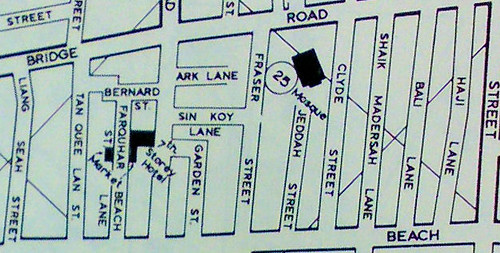
Initially I thought it was "Farquhar Beach". The name is too incredulous, so I looked harder. Actually it is Farquhar Street and Beach Lane.
But strange! Why is this street, itself short enough, divided into two stretch? Furthermore, where does Farquhar Street end and Beach Lane start?
The old street directory doesn't help much. With no landmarks, any division along a road is just arbitrary.
Let's look at what the aerial photo has to offer.
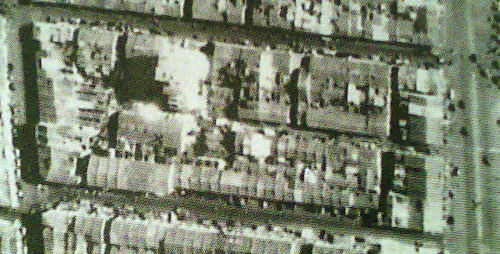
Taken in the 1950s. The plot of land is bounded by North Bridge Road(left), Rochor Road(top), Beach Road(right) and Tan Quee Lan Street(bottom). Farquhar Street and Beach Lane runs along the middle. Bernard Street is also visible.
I can see two possible divisions. If we walk down from 7th Storey Hotel to Beach Road, there are two lanes on the left that will lead you to Rochor Road. So there could be a street sign on the shophouse wall that says "Beach Lane" on either T-junction.
Interestingly, Farquhar Street and Beach Lane are also known by their Hokkien names. According to Toponymics, Farquhar Street is known as go cho lut bo bue hang and Beach Lane as thih pa sat khut thau hang.
I'm not that familiar with dialects, so I'm guessing the former means "梧槽路 dead end" and the latter mean something like "to go 铁巴刹, walk there".
The thih pa sat (铁巴刹) is Clyde Terrace Market which I'd probably cover in a later post. The association of Farquhar Street with Rochor Road (梧槽路) is a bit confusing until we realize Bernard Street is also known by the same name.
However, it is still puzzling why Bernard Street is a blind alley off Rochor Road. The street is wide enough for cars to pass. From the old street directory and aerial photo, it looks possible to drive your car from Tan Quee Lan Street to Rochor Road via Bernard Street. Or vice versa if the street is one way.
In fact, I found evidence of double yellow lines along Bernard Street, Farquhar Street and Beach Lane. Not sure whether they were added later. Still, it is pretty amazing to see road markings on expunged roads.
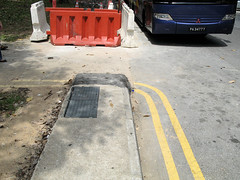

Left: Bernard Street junction with Tan Quee Lan Street. Right: The view after turning into Bernard Street.
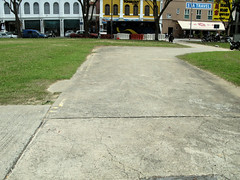
From road to pavement. Today pedestrians walk on it, but still possible for vehicles to travel to reach the backlane of New 7th Storey Hotel.
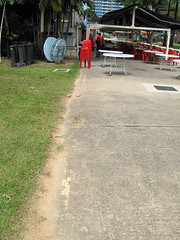

Left: Farquhar Street from Bernard Street. Right: Farquhar Street from Beach Lane side. In both pictures, New 7th Storey Hotel is visible
Opened in May 2006, this 6500 cubic metres balloon flying at 180m (48 storeys) is the world's largest tethered helium balloon.

Source: UcanFly website. The balloon is operated by the same guys who brought us Duck and Hippo tours.
If you take the Balloon up, you would be able to make out the outline of the three roads. But do hurry, because the Balloon will operate until August 2008....
Back to the ground. At its junction with Beach Road, Beach Lane, or what was once Beach Lane, is still visible.
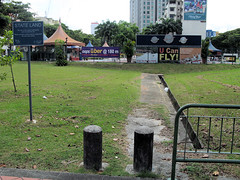
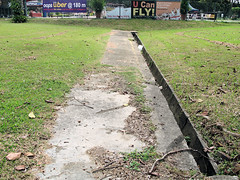
Left: Beach Lane. Right: Beach Lane close up, note the yellow lines again.
Looking at the photos again, i realize Beach Lane is not as well preserved as its neighbors. Only part of the road is visible. Further up, the hotel actually uses Farquhar Street for its backlane dining experience.
From research, I found out Beach Lane is known also as 面线巷. Translated, it would be "Mee Sua Lane". Perhaps this place was famous for Mee Sua last time.
Back to the topic. I started this post about William Farquhar, so let's end it with him. Do you know how Bernard Street got its name?
The street got its name after Francis James Bernard who held multiple titles like Master Attendant (1819-20), Chief of Police (1820-24) and also owner of Singapore Chronicle, Singapore's first newspaper.
But wait! What has he got to do with William Farquhar??
Simple .... he was the Colonel's son-in-law. :P
As the first Resident of Singapore (1819-23), his picture is plastered over our history books.
 Together with Raffles, the man who founded modern Singapore, they are etched in the minds of local students. I remember Farquhar as the balding guy in No. 1 uniform.
Together with Raffles, the man who founded modern Singapore, they are etched in the minds of local students. I remember Farquhar as the balding guy in No. 1 uniform.However, these two ang mohs who share the same chapter in our books ended up buay gam with each other. Raffles fired Farquhar over differences in administration and the issue was escalated by Farquhar to the Court of Directors of the East India Company. In his rebuttals, Raffles downplayed Farquhar's contributions and portrayed him only as an assistant in the formation of the Singapore settlement.
For his role in building the Settlement, you'd expect at least a road to be named after him. Unfortunately there is none. The last one was expunged about a decade ago.
So where was Farquhar's road?
Its location was brought to my attention while I was checking the old street directory for another blog entry.

Initially I thought it was "Farquhar Beach". The name is too incredulous, so I looked harder. Actually it is Farquhar Street and Beach Lane.
But strange! Why is this street, itself short enough, divided into two stretch? Furthermore, where does Farquhar Street end and Beach Lane start?
The old street directory doesn't help much. With no landmarks, any division along a road is just arbitrary.
Let's look at what the aerial photo has to offer.

Taken in the 1950s. The plot of land is bounded by North Bridge Road(left), Rochor Road(top), Beach Road(right) and Tan Quee Lan Street(bottom). Farquhar Street and Beach Lane runs along the middle. Bernard Street is also visible.
I can see two possible divisions. If we walk down from 7th Storey Hotel to Beach Road, there are two lanes on the left that will lead you to Rochor Road. So there could be a street sign on the shophouse wall that says "Beach Lane" on either T-junction.
Interestingly, Farquhar Street and Beach Lane are also known by their Hokkien names. According to Toponymics, Farquhar Street is known as go cho lut bo bue hang and Beach Lane as thih pa sat khut thau hang.
I'm not that familiar with dialects, so I'm guessing the former means "梧槽路 dead end" and the latter mean something like "to go 铁巴刹, walk there".
The thih pa sat (铁巴刹) is Clyde Terrace Market which I'd probably cover in a later post. The association of Farquhar Street with Rochor Road (梧槽路) is a bit confusing until we realize Bernard Street is also known by the same name.
However, it is still puzzling why Bernard Street is a blind alley off Rochor Road. The street is wide enough for cars to pass. From the old street directory and aerial photo, it looks possible to drive your car from Tan Quee Lan Street to Rochor Road via Bernard Street. Or vice versa if the street is one way.
In fact, I found evidence of double yellow lines along Bernard Street, Farquhar Street and Beach Lane. Not sure whether they were added later. Still, it is pretty amazing to see road markings on expunged roads.


Left: Bernard Street junction with Tan Quee Lan Street. Right: The view after turning into Bernard Street.

From road to pavement. Today pedestrians walk on it, but still possible for vehicles to travel to reach the backlane of New 7th Storey Hotel.


Left: Farquhar Street from Bernard Street. Right: Farquhar Street from Beach Lane side. In both pictures, New 7th Storey Hotel is visible
Today it is not possible to walk down Farquhar Street/Beach Lane to Beach Road from Bernard Street. The cute DHL balloon, the big icon greeting motorists travelling from ECP to Bugis, stands on the area.
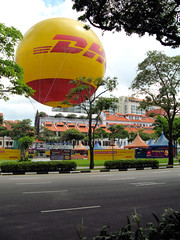
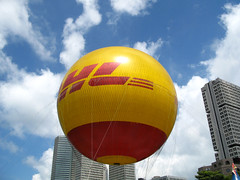
Left: Balloon from opposite side of Rochor Road. Right: Balloon from Farquhar Street.

Opened in May 2006, this 6500 cubic metres balloon flying at 180m (48 storeys) is the world's largest tethered helium balloon.

Source: UcanFly website. The balloon is operated by the same guys who brought us Duck and Hippo tours.
If you take the Balloon up, you would be able to make out the outline of the three roads. But do hurry, because the Balloon will operate until August 2008....
Back to the ground. At its junction with Beach Road, Beach Lane, or what was once Beach Lane, is still visible.


Left: Beach Lane. Right: Beach Lane close up, note the yellow lines again.
Looking at the photos again, i realize Beach Lane is not as well preserved as its neighbors. Only part of the road is visible. Further up, the hotel actually uses Farquhar Street for its backlane dining experience.
From research, I found out Beach Lane is known also as 面线巷. Translated, it would be "Mee Sua Lane". Perhaps this place was famous for Mee Sua last time.
Back to the topic. I started this post about William Farquhar, so let's end it with him. Do you know how Bernard Street got its name?
The street got its name after Francis James Bernard who held multiple titles like Master Attendant (1819-20), Chief of Police (1820-24) and also owner of Singapore Chronicle, Singapore's first newspaper.
But wait! What has he got to do with William Farquhar??
Simple .... he was the Colonel's son-in-law. :P
Jun 21, 2008
Terrain Features
Posted by
Icemoon
Given a map, can you identify the terrain features? If your geography lessons are but a distant memory like mine, then it is time for a refresher course.
On identifying terrain features, the US Army require their soldiers to identify five major and three minor ones on a map:
Major Terrain Features
This, I wasn't taught in my geography classes.
The study guide contains short instructions with useful illustrations on identifying the terrain. Do check it out.
On identifying terrain features, the US Army require their soldiers to identify five major and three minor ones on a map:
Major Terrain Features
- Hill
- Ridge
- Valley
- Saddle
- Depression
- Draw
- Spur
- Cliff
This, I wasn't taught in my geography classes.
The study guide contains short instructions with useful illustrations on identifying the terrain. Do check it out.
Why is Clementi Labelled Pasir Panjang?
Posted by
Icemoon
Lam Chun See posted a question in his blog about why in the 1981 and 1963 street directories, the area south of Ulu Pandan Road and Sungei Ulu Pandan was known as Pasir Panjang. I might have found the answer.
In the July 1972 street directory, there is a very important map pullout in the appendix. Here is a picture using my camera phone:
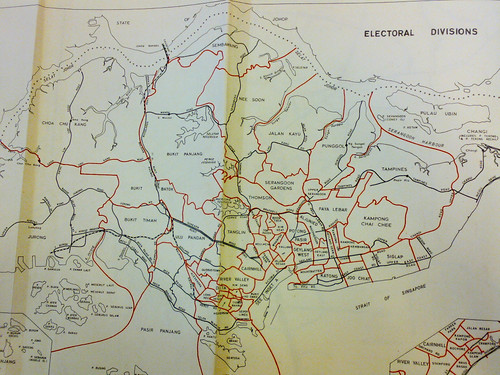
The Pasir Panjang area, enlarged:
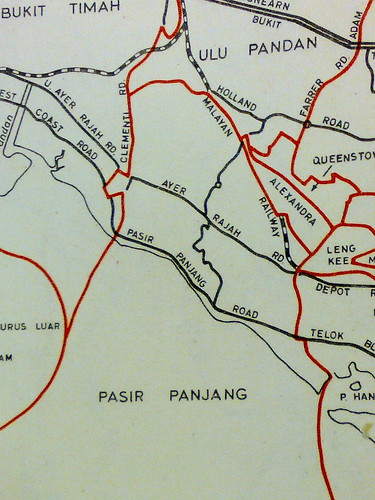
If we compare the photo by Chun See with the area demarcated by the electoral map, it is possible that Pasir Panjang on Chun See's map is a label for the electoral division.
A bit of history. Pasir Panjang used to be a Group Representation Constituency (GRC) by itself. In 1991, it merged with Brickworks GRC to become, erm, Brickworks GRC. In 1996, Brickworks GRC was scrapped. Today the area is under West Coast GRC.
There is another possibility though.
The same street directory reveals another interesting map:
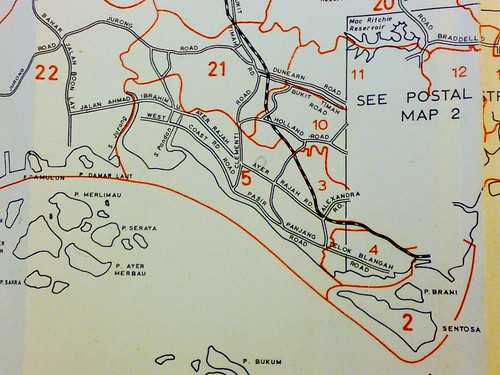
It is a map of the postal districts then. Notice how the area labelled 'Pasir Panjang' on Chun See's map is in district 5.
Interestingly, postal districts are demarcated in certain areas by the Sungei. For example, Sungei Ulu Pandan draws the boundary between 5, 10 and 21.
In the same street directory, two postal districts (5 and 21) divide up Clementi Road. However I notice something strange. From how the milestone is recorded, Clementi Road should start from the southern, Pasir Panjang, side, but where is the stretch before the 7 milestone??

By 1981, Postal Districts had made way for Postal Codes:
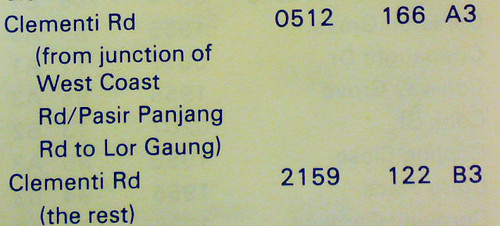
Once again, Clementi Road is divided into two. However this time, the boundary is pushed further up. Back in 1972, the boundary was at the 9 1/2 milestone which, according to the postal district map above, is just before the Clementi Road and Ulu Pandan Road junction. The milestone is not marked on the street map, so I'm making an educated guess based on the island map above.
By 1981, the boundary is at Lorong Gaung. This has disappeared, but its location is just opposite the present Corona Florist nursery. I will blog about this next time, but meanwhile do read Peter Chan's fascinating entry on it.
Back to our title question. Both my hypotheses have their weaknesses. On the electoral map, the area to the left of Clementi Road (future Clementi New Town) falls under Bukit Timah. The Pasir Panjang label, however, cuts into the area left of Clementi Road. On the postal district map, no such problem, however this time the label cuts across Sungei Ulu Pandan.
To summarize, the electoral map uses major roads to demarcate boundaries. The postal district map uses rivers. The Pasir Panjang label, unfortunately, cuts across the road and the river.
In the July 1972 street directory, there is a very important map pullout in the appendix. Here is a picture using my camera phone:

The Pasir Panjang area, enlarged:

If we compare the photo by Chun See with the area demarcated by the electoral map, it is possible that Pasir Panjang on Chun See's map is a label for the electoral division.
A bit of history. Pasir Panjang used to be a Group Representation Constituency (GRC) by itself. In 1991, it merged with Brickworks GRC to become, erm, Brickworks GRC. In 1996, Brickworks GRC was scrapped. Today the area is under West Coast GRC.
There is another possibility though.
The same street directory reveals another interesting map:

It is a map of the postal districts then. Notice how the area labelled 'Pasir Panjang' on Chun See's map is in district 5.
Interestingly, postal districts are demarcated in certain areas by the Sungei. For example, Sungei Ulu Pandan draws the boundary between 5, 10 and 21.
In the same street directory, two postal districts (5 and 21) divide up Clementi Road. However I notice something strange. From how the milestone is recorded, Clementi Road should start from the southern, Pasir Panjang, side, but where is the stretch before the 7 milestone??

By 1981, Postal Districts had made way for Postal Codes:

Once again, Clementi Road is divided into two. However this time, the boundary is pushed further up. Back in 1972, the boundary was at the 9 1/2 milestone which, according to the postal district map above, is just before the Clementi Road and Ulu Pandan Road junction. The milestone is not marked on the street map, so I'm making an educated guess based on the island map above.
By 1981, the boundary is at Lorong Gaung. This has disappeared, but its location is just opposite the present Corona Florist nursery. I will blog about this next time, but meanwhile do read Peter Chan's fascinating entry on it.
Back to our title question. Both my hypotheses have their weaknesses. On the electoral map, the area to the left of Clementi Road (future Clementi New Town) falls under Bukit Timah. The Pasir Panjang label, however, cuts into the area left of Clementi Road. On the postal district map, no such problem, however this time the label cuts across Sungei Ulu Pandan.
To summarize, the electoral map uses major roads to demarcate boundaries. The postal district map uses rivers. The Pasir Panjang label, unfortunately, cuts across the road and the river.












